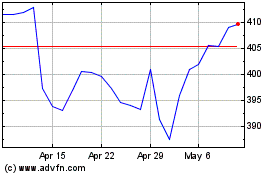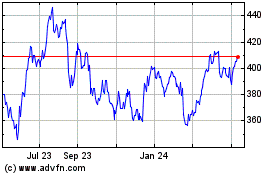By James R. Hagerty
When he was named chief executive of Deere & Co. in 1982,
Robert Hanson became the first head of the maker of agricultural
equipment who wasn't related to the founding family by blood or
marriage. His timing could have been better.
The U.S. agricultural boom of the 1970s, fueled partly by grain
exports to the Soviet Union, had given way to what became known as
the farm crisis. A strong dollar choked off exports, land and crop
prices slumped, and soaring interest rates ruined overly indebted
farmers.
Mr. Hanson, an ex-Marine, slashed labor costs but avoided
closing plants and remained upbeat. By the late 1980s, sales were
recovering.
Mr. Hanson, who had been crippled by a stroke 12 years ago while
golfing, died of complications from pneumonia May 19 at the age of
91.
Deere, founded in 1837 to make steel plows, survived the farm
crisis as an independent company, while rivals such as
International Harvester were swallowed up.
"He was extremely upbeat," said Robert Lane, who worked under
Mr. Hanson in the 1980s and was later CEO of Deere. "In the most
difficult of days, he would come into the office energized,
optimistic."
Colleagues remember him manning the grill at a picnic
celebrating Deere's 150th birthday in 1987.
Robert Arthur Hanson, born Dec. 13, 1924, grew up near the
company headquarters in Moline, Ill. His father, Nels Arthur
Hanson, worked for Deere. The younger Mr. Hanson earned a degree in
economics at Augustana College in Rock Island, Ill., and served in
the Marines in the Pacific during World War II before joining Deere
in 1950.
His rise through the ranks came under CEO William Hewitt, a
cosmopolitan executive who spoke French, had studied at Harvard
Business School and married into the Deere family. Mr. Hewitt built
a new headquarters, stocked it with art including a Chagall
painting and a Henry Moore sculpture and added a Japanese rock
garden and a pond graced by swans.
Mr. Hewitt was determined to make Deere a global company. One
result was that Mr. Hanson was given Spanish lessons and sent
abroad. He had postings in Mexico, Nicaragua, Guatemala and Spain,
and later headed the overseas division.
When Mr. Hanson became chairman and chief executive in 1982, it
was no time to buy art masterpieces. Even so, Deere kept the
collection amassed by Mr. Hewitt and continued to entertain guests
with Bordeaux from its well-stocked wine cellar. Company executives
reasoned that analysts, money managers and potential employees
visiting from the coasts should be shown that Moline was
civilized.
With farm incomes falling, sales of some of Deere's most
important types of machinery plunged 70% in the 1980s. Deere cut
its payroll to about 38,000 in 1987 from 61,000 in 1981.
A five-month strike by the United Auto Workers in 1986 and 1987
idled plants in six states. Some union members displayed coffins
outside the headquarters. Workers ended the strike by accepting a
wage freeze and creation of a job-protection plan.
Though some factories operated at less than 50% of capacity, Mr.
Hanson didn't close them. Deere used some of its spare capacity to
make parts for cars and motor homes.
Under today's management thinking, with more rigorous controls
over the costs of idle assets, plants probably would have been
closed, said Mr. Lane, who was CEO from 2000 to 2009. But he
credited Mr. Hanson with maintaining morale and forcing through
unpopular changes. For example, Mr. Hanson made Deere's financing
department independent rather than letting it be controlled by
executives responsible for selling equipment. That led to a much
stronger financing arm, Mr. Lane said.
Bernard Hardiek, another former senior Deere executive, said Mr.
Hanson "was not a flashy guy" but supported corporate morale in the
dark days by always insisting that the company's best years were
still ahead.
After retiring from Deere in 1990, Mr. Hanson and his wife,
Patricia, were supporters of the Quad City Symphony Orchestra and
donated $8 million for a new science building at Augustana College.
They maintained homes in Moline and Jupiter Island, Fla.
Mr. Hanson, who played the piano, during his retirement built a
violin and learned to play it. After a stroke confined him to a
wheelchair, he continued traveling widely.
Mr. Hanson's survivors include his wife of 61 years and a niece,
Lisa Wood of West Chester, Ohio. The couple had no children.
Write to James R. Hagerty at bob.hagerty@wsj.com
(END) Dow Jones Newswires
May 28, 2016 02:47 ET (06:47 GMT)
Copyright (c) 2016 Dow Jones & Company, Inc.
Deere (NYSE:DE)
Historical Stock Chart
From Mar 2024 to Apr 2024

Deere (NYSE:DE)
Historical Stock Chart
From Apr 2023 to Apr 2024
